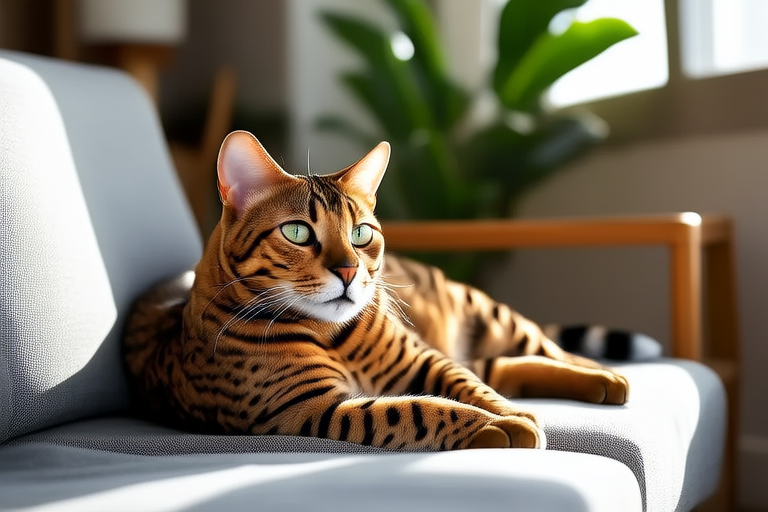From Jungle to Living Room: Understanding Your Bengal Companion
Welcome to the fascinating world of Bengal cats! These magnificent creatures have captured the hearts of many pet lovers with their striking appearance and dynamic personalities. In this article, we’ll explore the origins of Bengal cats, delve into their unique characteristics, and provide essential information on how to care for these energetic companions.
The Origins of Bengal Cats
Bengal cats trace their roots back to the wild Asian leopard. The breeding program began in the 1960s when Jean Mill crossed a domestic shorthair with an Asian leopard cat. Over several generations, breeders worked tirelessly to enhance the exotic looks of the leopard while maintaining the gentle temperament of a domestic cat. Today, Bengals are recognized as one of the most popular cat breeds, cherished for their stunning appearance and lively demeanor.
Distinctive Appearance
Bengal cats are easily recognizable thanks to their sleek, muscular bodies and striking coat patterns. Their coats often feature spots or marbled patterns that resemble those of their wild ancestors. The most common coat colors include brown, silver, and snow. One of the defining features of Bengal cats is their large, almond-shaped eyes, which can be green, gold, or blue. These expressive eyes add to their captivating appearance, making them a visual treat for any cat lover.
Energetic and Playful Nature
Bengals are known for their high energy levels and playful nature. They are curious and love to explore their surroundings, often engaging in activities that mimic hunting behaviors. Owners of Bengal cats frequently report their pets’ enthusiasm for playing fetch and chasing toys. Due to their active lifestyle, Bengals require plenty of mental and physical stimulation to stay happy and healthy. Providing interactive toys and ample space for play is crucial in meeting their needs.
Caring for Your Bengal Cat
Diet
Feeding your Bengal cat a balanced diet is essential for maintaining their health and energy levels. High-quality commercial cat food that meets their nutritional requirements is recommended. Many owners choose to supplement their cat’s diet with fresh meats like chicken or fish. Always consult with your veterinarian to determine the best diet for your Bengal based on age, weight, and overall health.
Exercise and Play
Given their high activity levels, Bengal cats need regular exercise to prevent boredom and obesity. Interactive toys, such as laser pointers, feather wands, and puzzle feeders, can keep them entertained and engaged. Encouraging play sessions several times a day will help channel their energy positively. Providing climbing structures and scratching posts also allows them to engage in natural behaviors.
Grooming
Bengals have short, dense coats that require minimal grooming. However, regular brushing helps remove loose fur and prevents matting. Bathing may be necessary occasionally, especially if your Bengal has been rolling around in something messy. Trim their nails regularly and clean their ears gently to maintain good hygiene.
Health Considerations
Bengal cats are generally healthy, but they can be prone to certain conditions, such as hip dysplasia and heart disease. Regular veterinary check-ups and routine screenings are vital to catch any potential issues early. Maintaining a healthy weight and providing proper nutrition can significantly reduce the risk of these conditions.
Creating a Stimulating Environment
To ensure your Bengal cat thrives, it’s important to create an enriching environment that caters to their active lifestyle. Set up multiple levels within your home, allowing your cat to climb and explore. Provide various hiding spots and perches for them to feel secure. Rotate toys periodically to keep them interested and engaged. Incorporating water fountains and bird feeders outside windows can also offer additional entertainment.
Anecdotes and Stories
Many Bengal owners share stories of their cats’ remarkable personalities and strong bonds with their human companions. One owner recounts how her Bengal, named Luna, would follow her everywhere, even joining her in yoga sessions. Another story tells of a Bengal who became an expert at opening cabinets and retrieving treats, much to the amusement of his family. These tales highlight the unique and endearing qualities of Bengal cats.
One particularly memorable incident involved a Bengal named Max, who was known for his adventurous spirit. One day, Max managed to escape from the backyard and spent hours exploring the neighborhood. When he finally returned home, he was greeted with open arms and a hearty meal. His owner, Sarah, shared that despite the scare, Max’s curiosity and resilience were what made him so special.
In another instance, a Bengal named Oreo demonstrated his affectionate side by curling up next to his owner every night, providing comfort and companionship. His owner, Tom, often remarked on how Oreo’s presence brought warmth and joy to his life. These stories illustrate the deep emotional connections Bengal cats can form with their owners.
Lastly, there’s the tale of a Bengal named Zara, who had a particular fondness for water. She would sit by the bathtub whenever it was running, watching intently. One day, Zara decided to take a dip herself, much to the surprise of her owner, Emily. Since then, baths became a fun bonding experience for both of them.
Conclusion
Bengal cats are truly one-of-a-kind companions, offering a blend of wild beauty and domestic charm. From their striking appearance to their playful and energetic nature, these cats bring joy and excitement to their owners’ lives. By understanding their origins, needs, and personalities, you can ensure your Bengal cat leads a happy and fulfilling life. Whether you’re a first-time cat owner or a seasoned pet enthusiast, welcoming a Bengal into your home promises an unforgettable journey filled with love, laughter, and adventure.
